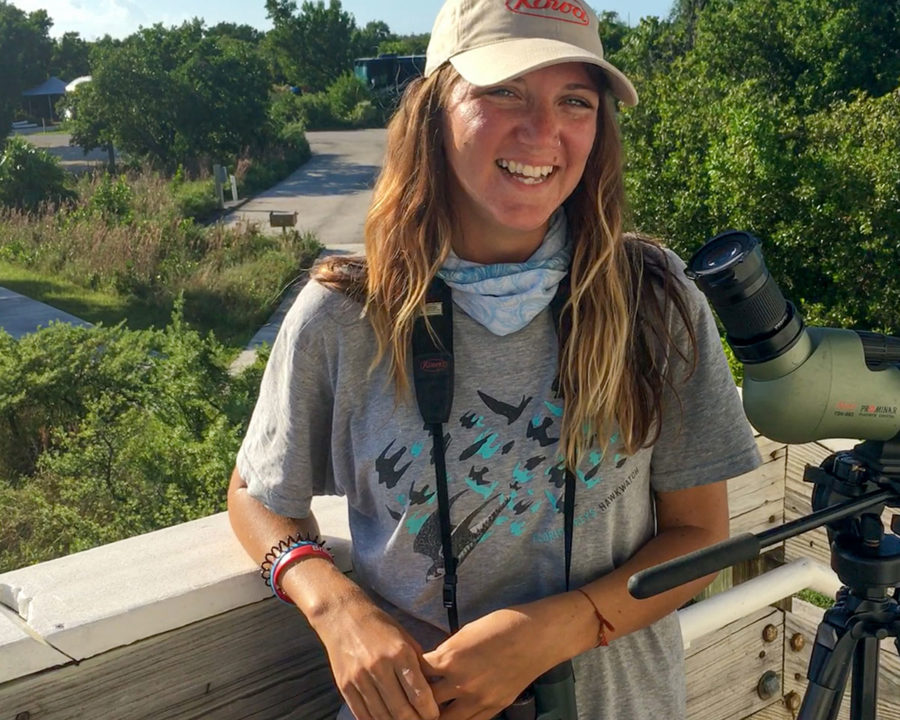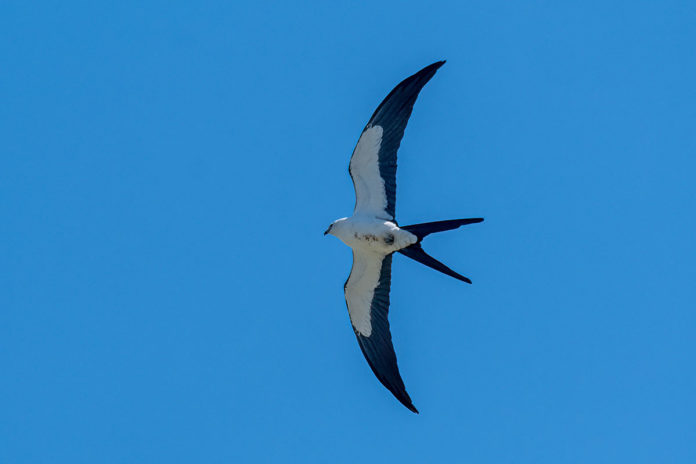Mariah Hryniewich started the Florida Keys Hawkwatch on Aug. 1 this year. For the first three days, hawk counter extraordinaire Jeff Bouton was there with her, but after that she was on her own. In previous years she’d worked the count with Luis Gles who was, if not her partner in crime, then her partner in avian enumeration. But Gles had been up on St. Paul Island on the Bering Sea in Alaska all summer, guiding and finding rare bird after rare bird, and wouldn’t be back for a couple weeks.
So it was just Hryniewich standing on the wooden deck that’s attached to the bathhouse in the campground at Curry Hammock State Park – Hryniewich and the occasional curious camper.
Before last year the count started on Sept. 1, and they would count every bird of prey they could see fly by on the way south, but then someone got the idea that the project should try to accommodate the swallow-tailed kite migration.
Swallow-tailed kites are, as the kids say, a little extra. Sure, they are gorgeous – with their white plumage and all the black edging, and their long, v-shaped, streamer-like tails. And the relaxed, assured beauty with which they loop in the sky is just heart-achingly beautiful. They have the ability to find breezes and updrafts in the stillest of air. But also, they migrate half a season earlier than the other raptors. And they don’t seem as inclined to follow the flight lines that other species largely follow. And nobody really understands the full mechanics or routes of their migration.
The people who know the most are the folks at the Avian Research and Conservation Institute (ARCI), a lean, mean research group out of Gainesville. They’ve been attaching very small satellite trackers onto swallow-tails for a number of years, and seeing the routes of individual kites as they move primarily from northern Florida and the Carolinas down to the Pampas of South America. But how many birds are traveling which routes is still something of an unknown.
Hryniewich had worked with ARCI over the summer, helping attach a transmitter to a kite in North Carolina, and then doing aerial surveys of their collective pre-migration roosts from a plane.
“It was like seeing snow-capped mountains. Except it was snow-capped cypress trees. In Florida. And they were all swallow-tailed kites. It was incredible. Hundreds of birds, thousands of birds,” she said. She was looking forward to seeing how many of those birds migrated through the Keys.
Last year, they’d seen 31 swallow-tails on the third day, then had a steady flow through mid-September, counting 1,619 birds throughout the season.
This year she counted five on the third day, and then, well, nothing. Maybe she’d count a handful of ospreys. Maybe she’d get to see the local bald eagle. But mostly it was hour after hour, day after day, of hot, empty skies.
“I was trying to keep myself in high spirits. But some days it was harder than others,” she said.
She started to worry that instead of migrating through the Keys and the Caribbean, they were all taking a more westerly route.
“Texas was getting numbers early in the season and I wasn’t. And I was like, what? They’re all over there this year?” she said. “I felt defeated some days.”

One of the things that gave her hope was that ARCI had a total of 10 kites with transmitters attached, and they were all still milling about on the Florida mainland.
But then, on Aug. 13, there was a glimmer of something.
“Honestly, earlier in that day, I just felt like the winds were different. It was hot. Very, very hot.
And I just felt it – this is the day it’s gonna happen. And then it happened.”
It was about 4 p.m. Quitting time, because you rarely see daytime migrants much after that.
“I was collapsing my scope, getting ready to leave. And I just looked up and I saw a kettle,” she said. “I screamed.”
Finally, after all those days of nothing, there was a sizable flock of swallow-tails – 93 of them – all swirling around together on the thermals.
The next day, again around quitting time, she had a flock of 228. The next, 265.
On Aug. 16 the pattern changed somewhat. She counted 150 swallow-tailed kites before noon, then a slow trickle of them, then around 4 p.m. an even bigger cloudburst of birds. Gles was just about back from Alaska, and was going to stop at their housing in Layton, when he called Hryniewich. He decided to drive to the park instead, and by 6 p.m. they’d counted a total of 609 birds for the day, but also the lowest altitude flight of the season.
“And then the next day was incredible,” Hryniewich said.
They had 1,438 swallow-tailed kites that day; the most dramatic part was around 11:30 a.m., when they counted 909 kites flying over the site in a span of 11 minutes, the kettle of birds stretching from horizon to horizon.
They’d seen almost as many birds in a day as they had in all the season before.
“Swallow-tailed kites are different. They maneuver however they want, they take whatever track they want. They play with the wind. They love it,” Hryniewich said.
She said she feels like she’s developed something of a sense for them.
“It can be so hot, and there’s no-see-ums, and the bugs are getting you, and you’re just sweating. But the days I had kites, I was sweating even more. I’m telling you I could feel it,” she said. “You know when birds migrate – like their general timeframe (during the year). But to actually see it and start to understand it and understand the weather patterns that go with them.
It’s really cool. It makes it a lot more fun, and a lot more interesting. And it all starts to make a lot more sense,” she said.
“But that’s not the word I’m looking for,” she added, and laughed.



















